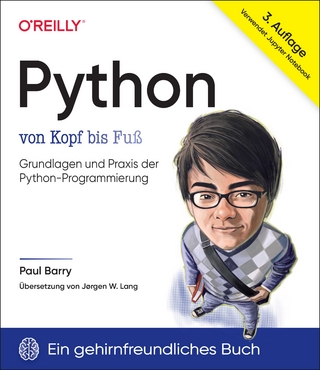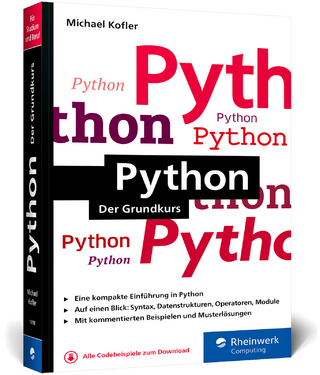
Professional Python
John Wiley & Sons (Verlag)
978-1-119-07085-6 (ISBN)
- Titel ist leider vergriffen;
keine Neuauflage - Artikel merken
Design better architecture and write easy-to-understand code using highly adoptable techniques that result in more robust and efficient applications.
Coverage includes Decorators, Context Managers, Magic Methods, Class Factories, Metaclasses, Regular Expressions, and more, including advanced methods for unit testing using asyncio and CLI tools. Each topic includes an explanation of the concept and a discussion on applications, followed by hands-on tutorials based on real-world scenarios.
All sample code is available for download from the companion website, and the "Python 3 first" approach covers multiple current versions, while ensuring long-term relevance. Python offers many tools and techniques for writing better code, but often confusing documentation leaves many programmers in the dark about how to use them.
This book shines a light on these incredibly useful methods, giving you clear guidance toward building stronger applications.
- Learn advanced Python functions, classes, and libraries
- Utilize better development and testing tools
- Understand the "what," "when," "why," and "how"
- Download example code to start programming right away
More than just theory or a recipe-style walk-through, this guide helps you learn and understand these little-known tools and techniques. You'll streamline your workflow while improving the quality of your output, producing more robust applications with cleaner code and stronger architecture.
If you're ready to take your Python skills to the next level, Professional Python is the invaluable guide that will get you there.
Luke Sneeringer is a Python developer whose home is in Austin (Texas, USA), where he works as a developer for Ansible.
INTRODUCTION xxv
PART I: FUNCTIONS
CHAPTER 1: DECORATORS 3
Understanding Decorators 3
Decorator Syntax 4
Order of Decorator Application 5
Where Decorators Are Used 6
Why You Should Write Decorators 6
When You Should Write Decorators 7
Additional Functionality 7
Data Sanitization or Addition 7
Function Registration 7
Writing Decorators 7
An Initial Example: A Function Registry 7
Execution-Time Wrapping Code 9
A Simple Type Check 9
Preserving the help 10
User Verification 11
Output Formatting 12
Logging 14
Variable Arguments 15
Decorator Arguments 16
How Does This Work? 17
The Call Signature Matters 18
Decorating Classes 20
Type Switching 22
A Pitfall 24
Summary 25
CHAPTER 2: CONTEXT MANAGERS 27
What Is a Context Manager? 27
Context Manager Syntax 28
The with Statement 28
The enter and exit Methods 28
Exception Handling 29
When You Should Write Context Managers 30
Resource Cleanliness 30
Avoiding Repetition 31
Propagating Exceptions 31
Suppressing Exceptions 32
A Simpler Syntax 37
Summary 38
CHAPTER 3: GENERATORS 41
Understanding What a Generator Is 41
Understanding Generator Syntax 41
The next Function 43
The StopIteration Exception 45
Python 2 46
Python 3 47
Communication with Generators 47
Iterables Versus Iterators 49
Generators in the Standard Library 50
range 50
dict.items and Family 50
zip 51
map 51
File Objects 52
When to Write Generators 53
Accessing Data in Pieces 53
Computing Data in Pieces 54
Sequences Can Be Infi nite 54
When Are Generators Singletons? 54
Generators within Generators 55
Summary 56
PART II: CLASSES
CHAPTER 4: MAGIC METHODS 59
Magic Method Syntax 59
Available Methods 60
Creation and Destruction 61
__init__ 61
__new__ 62
__del__ 62
Type Conversion 63
__str__, __unicode__, and __bytes__ 63
__bool__ 64
__int__, __fl oat__, and __complex__ 65
Comparisons 65
Binary Equality 65
Relative Comparisons 67
Operator Overloading 68
Overloading Common Methods 71
Collections 75
Other Magic Methods 77
Summary 77
CHAPTER 5: METACLASSES 79
Classes and Objects 79
Using type Directly 80
Creating a Class 81
Creating a Subclass 81
The type Chain 82
The Role of type 82
Writing Metaclasses 83
The new Method 83
new Versus init 83
A Trivial Metaclass 84
Metaclass Inheritance 84
Using Metaclasses 87
Python 3 87
Python 2 88
What About Code That Might Run on Either Version? 88
When Is Cross-Compatibility Important? 89
When to Use Metaclasses 89
Declarative Class Declaration 89
An Existing Example 89
How This Works 90
Why This Is a Good Use for Metaclasses 91
Class Verification 91
Non-Inheriting Attributes 93
The Question of Explicit Opt-In 94
Meta-Coding 95
Summary 97
CHAPTER 6: CLASS FACTORIES 99
A Review of type 99
Understanding a Class Factory Function 100
Determining When You Should Write Class Factories 102
Runtime Attributes 102
Understanding Why You Should Do This 103
Attribute Dictionaries 104
Fleshing Out the Credential Class 104
The Form Example 105
Dodging Class Attribute Consistency 106
Class Attributes Versus Instance Attributes 107
The Class Method Limitation 108
Tying This in with Class Factories 109
Answering the Singleton Question 109
Summary 111
CHAPTER 7: ABSTRACT BASE CLASSES 113
Using Abstract Base Classes 113
Declaring a Virtual Subclass 115
Why Declare Virtual Subclasses? 115
Using register as a Decorator 117
__subclasshook__ 117
Declaring a Protocol 119
Other Existing Approaches 119
Using NotImplementedError 120
Using Metaclasses 120
The Value of Abstract Base Classes 122
Abstract Properties 124
Abstract Class or Static Methods 125
Built-in Abstract Base Classes 126
Single-Method ABCs 126
Alternative-Collection ABCs 127
Using Built-In Abstract Base Classes 128
Additional ABCs 128
Summary 128
PART III: DATA
CHAPTER 8: STRINGS AND UNICODE 131
Text String Versus Byte String 131
String Data in Python 132
Python 3 Strings 132
Python 2 Strings 134
six 136
Strings with Non-ASCII Characters 136
Observing the Difference 136
Unicode Is a Superset of ASCII 137
Other Encodings 137
Encodings Are Not Cross-Compatible 138
Reading Files 139
Python 3 139
Specifying Encoding 139
Reading Bytes 140
Python 2 140
Reading Other Sources 141
Specifying Python File Encodings 141
Strict Codecs 143
Suppressing Errors 143
Registering Error Handlers 144
Summary 145
CHAPTER 9: REGULAR EXPRESSIONS 147
Why Use Regular Expressions? 147
Regular Expressions in Python 148
Raw Strings 148
Match Objects 149
Finding More Than One Match 149
Basic Regular Expressions 150
Character Classes 150
Ranges 151
Negation 151
Shortcuts 152
Beginning and End of String 153
Any Character 154
Optional Characters 154
Repetition 155
Repetition Ranges 155
Open-Ended Ranges 156
Shorthand 156
Grouping 157
The Zero Group 159
Named Groups 159
Referencing Existing Groups 160
Lookahead 161
Flags 163
Case Insensitivity 163
ASCII and Unicode 163
Dot Matching Newline 163
Multiline Mode 164
Verbose Mode 164
Debug Mode 164
Using Multiple Flags 165
Inline Flags 165
Substitution 165
Compiled Regular Expressions 166
Summary 167
PART IV: EVERYTHING ELSE
CHAPTER 10: PYTHON 2 VERSUS PYTHON 3 171
Cross-Compatibility Strategies 171
The __future__ Module 172
2to3 172
Writing Changes 173
Limitations 174
six 174
Changes in Python 3 175
Strings and Unicode 175
The print Function 176
Division 176
Absolute and Relative Imports 177
Removal of “Old-Style” Classes 178
Metaclass Syntax 179
six.with_metaclass 179
six.add_metaclass 180
Exception Syntax 180
Handling Exceptions 181
Exception Chaining 181
Dictionary Methods 182
Function Methods 183
Iterators 183
Standard Library Relocations 184
Merging “Fast” Modules 184
io 184
pickle 184
The URL Modules 185
Renames 185
Other Package Reorganizations 185
Version Detection 186
Summary 186
CHAPTER 11: UNIT TESTING 187
The Testing Continuum 187
The Copied Ecosystem 188
The Isolated Environment 188
Advantages and Disadvantages 189
Speed 189
Interactivity 189
Testing Code 190
Code Layout 190
Testing the Function 191
The assert Statement 192
Unit Testing Frameworks 192
Running Unit Tests 193
Failures 193
Errors 194
Skipped Tests 195
Loading Tests 196
Mocking 197
Mocking a Function Call 197
Asserting Mocked Calls 199
Inspecting Mocks 201
Call Count and Status 201
Multiple Calls 202
Inspecting Calls 203
Other Testing Tools 203
coverage 203
tox 204
Other Test Runners 205
Summary 205
CHAPTER 12: CLI TOOLS 207
optparse 207
A Simple Argument 207
name == ‘ main__’ 208
OptionParser 208
Options 209
Types of Options 209
Adding Options to OptionParser 209
Options with Values 210
Non-String Values 211
Specifying Option Values 212
Positional Arguments 214
Counters 214
List Values 215
Why Use optparse? 216
argparse 216
The Bare Bones 217
Arguments and Options 217
Option Flags 217
Alternate Prefi xes 218
Options with Values 219
Positional Arguments 222
Reading Files 223
Why Use argparse? 224
Summary 224
CHAPTER 13: ASYNCIO 225
The Event Loop 225
A Simple Event Loop 226
Running the Loop 226
Registering Tasks and Running the Loop 227
Delaying Calls 227
Partials 228
Running the Loop until a Task Completes 228
Running a Background Loop 229
Coroutines 230
Nested Coroutines 231
Futures and Tasks 232
Futures 232
Tasks 232
Callbacks 234
No Guarantee of Success 235
Under the Hood 235
Callbacks with Arguments 235
Task Aggregation 236
Gathering Tasks 236
Waiting on Tasks 237
Timeouts 238
Waiting on Any Task 239
Waiting on an Exception 239
Queues 240
Maximum Size 242
Servers 242
Summary 244
CHAPTER 14: STYLE 245
Principles 245
Assume Your Code Will Require Maintenance 245
Be Consistent 246
Think About Ontology, Especially with Data 246
Do Not Repeat Yourself 246
Have Your Comments Explain the Story 247
Occam’s Razor 247
Standards 248
Trivial Rules 248
Documentation Strings 248
Blank Lines 249
Imports 249
Variables 250
Comments 250
Line Length 251
Summary 251
INDEX 253
| Erscheint lt. Verlag | 24.11.2015 |
|---|---|
| Verlagsort | New York |
| Sprache | englisch |
| Maße | 188 x 233 mm |
| Gewicht | 508 g |
| Einbandart | kartoniert |
| Themenwelt | Informatik ► Programmiersprachen / -werkzeuge ► Python |
| Mathematik / Informatik ► Informatik ► Web / Internet | |
| Schlagworte | Python • Python (Programmiersprache); Einführung • Python (Programmiersprache); Handbuch/Lehrbuch |
| ISBN-10 | 1-119-07085-6 / 1119070856 |
| ISBN-13 | 978-1-119-07085-6 / 9781119070856 |
| Zustand | Neuware |
| Informationen gemäß Produktsicherheitsverordnung (GPSR) | |
| Haben Sie eine Frage zum Produkt? |
aus dem Bereich


